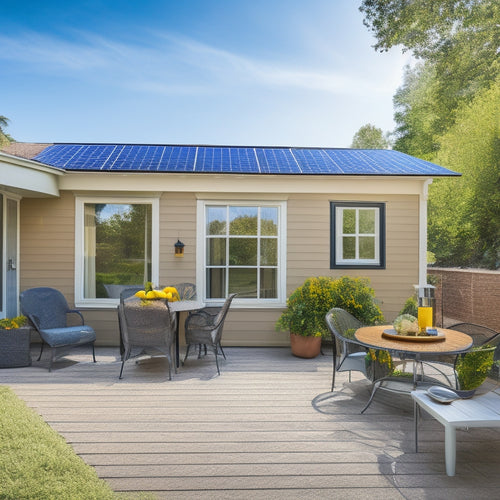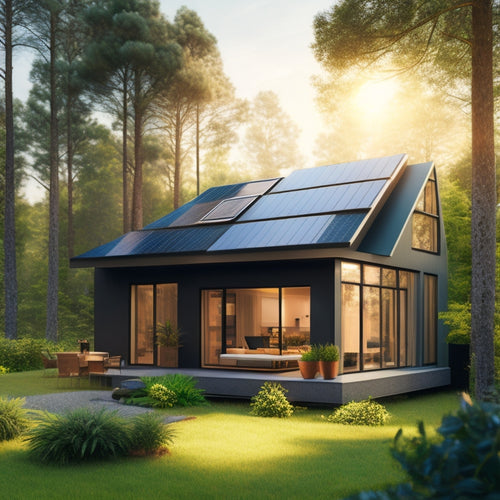
Home Solar Power Installation Guide
Share
As you prepare to utilize the power of the sun, a thorough home solar power installation guide is essential to guarantee a successful shift. Start by evaluating your solar readiness, reviewing energy efficiency, roof size, and local regulations. Next, choose the right solar panels, considering factors like panel efficiency, warranty, and manufacturer reputation. Then, plan your system size, analyzing energy usage and utility costs. Before installation, prepare the area, inspect the roof, and evaluate weather conditions. With a solid foundation in place, you'll be ready to tackle the installation process, and as you continue to investigate the world of solar power, you'll uncover even more revelations to optimize your system's performance and maximize your investment.
Key Takeaways
- Conduct an energy audit to identify energy-wasting culprits and ensure adequate sunlight exposure for optimal solar panel performance.
- Choose solar panels with high efficiency ratings (20% or higher) and long warranties (at least 25 years) for maximum energy production.
- Design the solar system to maximize energy production while minimizing costs, considering energy usage, inverter selection, and system size determination.
- Ensure a smooth installation process by preparing the roof area, assessing weather conditions, and verifying roof integrity before installation day.
- Connect to the grid safely by following lockout/tagout procedures, installing ground fault and arc fault protection, and scheduling regular inspections and safety training.
Assessing Your Solar Readiness
Your home's solar readiness is a critical factor in determining the viability of a solar power installation. Before investing in a solar system, you need to evaluate your home's energy efficiency and identify areas for improvement.
Conduct an energy audit to pinpoint energy-wasting culprits, such as inefficient appliances, insulation gaps, and single-pane windows. Upgrading to energy-efficient alternatives won't only reduce your energy consumption but also optimize your home's solar potential.
Your roof's size, orientation, and shading also play a significant role in your solar readiness. Verify your roof receives adequate sunlight throughout the day, and consider trimming nearby trees or installing skylights to maximize solar exposure.
Additionally, review local building codes and regulations to guarantee compliance. Financial incentives, such as tax credits and rebates, may be available for homeowners who invest in solar power.
Choosing the Right Solar Panels
Efficiency is crucial when it comes to utilizing solar power, and selecting the right solar panels is an essential decision in the installation process. You want to maximize energy production while minimizing space and cost.
To do this, focus on panel efficiency, which is measured by the amount of energy produced per unit area. Look for high-efficiency panels with a rating of 20% or higher.
When choosing a panel, you should also take into account the warranty offered by the manufacturer. A good solar warranty should cover the panel's performance, materials, and workmanship for at least 25 years. This guarantees that you're protected in case the panel's efficiency degrades over time.
You'll also want to reflect on the type of solar cells used in the panel. Monocrystalline silicon cells are the most efficient, but they're also the most expensive.
Polycrystalline silicon cells are a more affordable option, but they're slightly less efficient. Thin-film cells are the least efficient, but they're also the cheapest.
Ultimately, the right panel for you'll depend on your budget, space constraints, and energy needs.
Understanding Solar Panel Installation
You'll need to carefully evaluate solar panel selection criteria to guarantee the right panels for your system.
Next, you'll determine the ideal panel orientation and tilt to maximize energy production, considering factors like roof pitch and shading.
Solar Panel Selection Criteria
When it comes to utilizing solar energy, the quality and performance of solar panels play an essential role in determining the overall success of your home solar power installation.
You'll want to carefully evaluate solar panel selection criteria to guarantee you're getting the best possible system for your needs.
Solar panel efficiency is a critical factor to evaluate. Higher efficiency panels convert more sunlight into electricity, resulting in greater energy output per unit area. Look for panels with high efficiency ratings, typically above 18%.
Additionally, assess the type of solar cells used, such as monocrystalline or polycrystalline, as they affect efficiency and durability.
Another key aspect is solar panel warranties. Reputable manufacturers offer extensive warranties, typically 25 years or more, covering performance, materials, and workmanship.
This guarantees you're protected in case of defects or performance issues. Be sure to review warranty terms and conditions carefully before making a final decision.
Panel Orientation and Tilt
As your solar panel selection is finalized, attention turns to enhancing their installation, where panel orientation and tilt emerge as critical factors in utilizing maximum energy output.
You'll want to guarantee your panels face the ideal direction, typically south, to capture the most sunlight. However, if your roof doesn't allow for a south-facing orientation, don't worry – you can still achieve significant energy output with east- or west-facing panels.
The tilt of your panels is equally important, as it affects the angle at which sunlight hits the surface. A general rule of thumb is to tilt your panels at an angle equal to your latitude, but this may need to be adjusted based on your roof's pitch and local building codes.
Conduct a shade analysis to identify potential obstructions and adjust your panel orientation and tilt accordingly. Additionally, consider seasonal adjustments to enhance energy output during different times of the year.
System Sizing and Design
Determining the ideal system size and design is a critical step in understanding solar panel installation, requiring careful consideration of your energy needs and available roof space.
To get it right, you'll need to assess your current energy usage, factoring in aspects like your electricity bills, appliances, and lighting. This will help you determine the required system size in kilowatts (kW).
Next, you'll need to evaluate your roof's solar energy efficiency, considering factors like its orientation, tilt, and shading. This will help you determine the best system design, including the number and type of solar panels, inverter selection, and mounting hardware.
A well-designed system will maximize energy production while minimizing costs.
When selecting an inverter, consider its efficiency rating, maximum power point tracking (MPPT) capabilities, and compatibility with your panel array. A high-efficiency inverter will guarantee you get the most out of your solar energy system.
Planning Your Solar System Size
Your energy usage pattern plays an essential role in planning your solar system size. To determine the ideal size, you need to evaluate your energy consumption habits. Review your past utility bills to calculate your average daily energy usage in kilowatt-hours (kWh).
Consider the number of appliances, lighting, and HVAC systems in your home, as well as your energy-intensive habits, such as running multiple refrigerators or electric vehicle charging.
Next, analyze your utility costs to determine how much you can save by switching to solar power. Examine your energy consumption patterns to identify opportunities to reduce your reliance on the grid. This will help you optimize your solar system size and maximize your savings.
When planning your solar system size, consider factors like roof size, available space, and local building codes. Confirm your system is designed to meet your energy needs while complying with local regulations.
Preparing for Installation Day
Before the installation crew arrives, make certain your property is ready for the alteration by tackling a few vital tasks. Proper site preparation is essential to guarantee a smooth and efficient installation process.
You'll want to clear the area around your roof and make sure there are no obstructions, such as branches or skylights, that could hinder the installation crew's access.
Additionally, consider the weather conditions on installation day. Inclement weather can greatly impact the installation process, so it's important to have a contingency plan in place.
Verify that your roof is clear of debris and obstructions, and trim any tree branches that may be in the way.
To guarantee a successful installation, don't forget to:
- Clear your roof of debris and obstructions
- Trim tree branches that may be in the way
- Ensure easy access to your roof
- Have a plan in place for inclement weather
Installing Solar Mounting Hardware
You'll need to select the right mounting hardware options for your solar panel installation, considering factors like roof type, panel size, and local building codes.
Before making a final decision, you'll also need to assess your roof's structure to guarantee it can support the weight and stress of the solar panels and mounting hardware.
Mounting Hardware Options
Selecting the appropriate mounting hardware is a critical step in installing solar panels, as it directly affects the system's performance, durability, and overall safety.
You'll need to evaluate factors such as roof type, solar panel size, and local building codes to guarantee a secure and efficient installation.
When it comes to mounting hardware options, you have several choices:
-
Ground Mounted Systems: Ideal for large solar arrays or homes with limited roof space, these systems allow for greater flexibility in panel placement and easier maintenance.
-
Solar Racking: A popular choice for roof-mounted systems, solar racking provides a sturdy structure for your panels while also allowing for adjustments to optimize energy production.
-
Ballasted Mounting: This option uses weights to secure the solar panels to your roof, eliminating the need for penetration and making it ideal for flat or sensitive roofs.
- Rail-Based Mounting: A cost-effective and versatile option, rail-based mounting systems provide a strong foundation for your solar panels and can be adapted to various roof types.
Roof Structure Assessment
Get ready to dig in and assess your roof's structure, as it's crucial to guarantee a safe and secure installation of your solar mounting hardware.
You'll need to evaluate your roof's load-bearing capacity to confirm it can handle the added weight of the solar panels and mounting system. This includes considering factors like the roof's age, material, and condition, as well as any existing structural modifications or damage.
A thorough assessment will help you determine the maximum roof load your roof can support, maintaining the structural integrity of your home remains intact.
You'll want to inspect for signs of wear, such as cracks, sagging, or rotten wood, and identify any potential weaknesses that could compromise the installation.
Additionally, you'll need to verify that your roof's framing and decking can support the weight of the solar panels, which can range from 2-5 pounds per square foot.
Connecting to the Grid Safely
Frequently, homeowners who install solar power systems overlook the critical step of connecting to the grid safely. This oversight can have disastrous consequences, including electrical shock, fires, and even fatalities.
As you connect your solar power system to the grid, it's crucial to prioritize safety above all else.
To guarantee a safe grid connection, you must implement the following safety measures:
- Lockout/tagout procedures: Confirm that all electrical components are de-energized before performing maintenance or repairs.
- Ground fault protection: Install ground fault circuit interrupters (GFCIs) to detect and interrupt ground faults, preventing electrical shock.
- Arc fault protection: Use arc fault circuit interrupters (AFCIs) to detect and interrupt arcing faults, reducing the risk of electrical fires.
- Regular inspections: Schedule regular inspections to identify and address potential safety hazards before they become major issues.
Maintaining Your Solar System
As you've guaranteed a safe connection to the grid, your focus shifts to maintaining your solar system to optimize its performance and extend its lifespan.
Regular solar panel cleaning is essential to guarantee maximum energy output, so schedule cleanings every 6-12 months, depending on your location and climate.
Inverter maintenance is also significant, as faulty inverters can lead to system failure. Check your inverter's display for error codes and perform software updates as needed.
Proper battery upkeep is important for energy storage systems. Monitor your battery's state of charge, depth of discharge, and temperature to prevent overcharging or undercharging.
Performance monitoring is key to identify potential issues before they escalate. Keep an eye on your system's energy output and compare it to the manufacturer's specifications.
Schedule annual safety inspections to guarantee your system meets safety standards.
Consider system upgrades to improve efficiency or increase energy output. Manage your warranty effectively by keeping records of maintenance and repairs.
Frequently Asked Questions
Can I Install Solar Panels on a Metal Roof?
You can install solar panels on a metal roof, leveraging its advantages like durability and water-tightness. However, you'll need to contemplate installation specifics, such as specialized clamps, waterproofing, and ensuring the roof's structural integrity can support the added weight.
Are Solar Panels Resistant to Hail and Extreme Weather?
You'll be glad to know that solar panels are designed to withstand hail impact and extreme weather conditions, boasting impressive weather durability ratings that guarantee your energy production remains unaffected by Mother Nature's fury.
Do Solar Panels Work During a Power Outage?
You'll be pleased to know that solar panels don't provide power during a grid outage, as they're designed to sync with the grid's frequency. However, you can opt for backup power solutions, like battery storage, to guarantee continuous energy supply during outages.
Can I Add More Panels to My System Later?
Think of your solar panel system as a puzzle, easily expanded with new pieces. You can add more panels later, but guarantee compatibility and consider system expansion limitations to maintain ideal energy harvesting and avoid potential grid connection issues.
Will Solar Panels Void My Roof's Warranty?
You're wise to evaluate roof warranty implications; properly installed solar panels using approved techniques won't typically void your roof's warranty, but you'll want to review your warranty terms and verify the installation meets manufacturer requirements.
Related Posts
-

10 Tips to Buy Affordable Solar Panels Online
When purchasing affordable solar panels online, you'll want to research reputable retailers, compare prices, and chec...
-

Why Cities Need Smart Charging Infrastructure Now
You're about to experience a tidal wave of electric vehicles hitting your city's streets, and it's essential you're p...
-

Reduce Solar Panel Cost for Your Small Home
By evaluating your energy needs, choosing the right installer, and selecting cost-effective solar panel options, you ...


